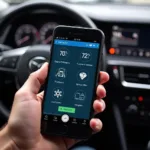The idea of starting your car through the OBD2 port might sound like something out of a spy movie, but is it actually possible? The OBD2 port, typically found under the driver’s side dashboard, is primarily known for diagnostics. It provides a wealth of information about your car’s engine, transmission, and other critical systems. However, its capability to start a vehicle is a topic shrouded in both curiosity and misinformation.
Understanding the OBD2 Port’s Functionality
To address the question of starting your car through the OBD2 port, it’s crucial to grasp its intended purpose. Originally designed to monitor emissions-related components, the OBD2 port has evolved into a comprehensive diagnostic interface. By connecting a compatible scan tool or code reader, mechanics and car owners can retrieve diagnostic trouble codes (DTCs), access live data streams from various sensors, and monitor the performance of critical systems.
While the OBD2 port offers valuable insights into your vehicle’s health, it’s not inherently designed for remote starting. The electrical pathways and communication protocols used for starting the engine are typically separate from those utilized by the OBD2 system.
Remote Start Systems and Their Connection (or Lack Thereof) to OBD2
Remote start systems, a popular aftermarket addition for convenience and comfort, function independently of the OBD2 port. These systems utilize dedicated hardware components, including a remote start module, that integrate with the car’s ignition system, starter, and other related components. The remote start module sends signals to these components, bypassing the conventional key-based ignition process to start the engine.
When OBD2 Indirectly Plays a Role in Starting Issues
While you can’t directly start your car through the OBD2 port, it can indirectly shed light on reasons why your car might not be starting. By connecting an OBD2 scanner, you can read diagnostic trouble codes that pinpoint potential issues affecting the starting process. For instance:
- Crankshaft Position Sensor Failure: The crankshaft position sensor provides vital information for ignition timing. A faulty sensor can prevent the engine from starting, and the OBD2 scanner will likely flag a corresponding code.
- Immobilizer System Malfunction: Modern cars often employ immobilizer systems that prevent unauthorized starting. If there’s a problem with the immobilizer, such as an issue with the key fob’s communication, it can prevent the engine from cranking, and the OBD2 system might register related codes.
- Fuel System Problems: Issues with the fuel pump, fuel pressure regulator, or injectors can hinder fuel delivery, preventing the engine from starting. The OBD2 system can help identify these problems through specific diagnostic trouble codes.
Conclusion
While the OBD2 port is an indispensable tool for diagnostics and understanding your car’s health, it’s not designed to start your vehicle. Remote start systems operate independently and require dedicated installation. However, the OBD2 port can be your ally in uncovering potential reasons behind starting problems, guiding you towards a solution and getting you back on the road.


